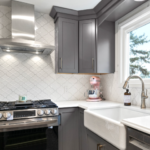1. Insulation: Adding insulation to your home can significantly improve energy efficiency by reducing heat transfer through the walls, roof, and floors. This helps maintain a comfortable temperature and reduces the need for heating or cooling.
2. Energy-Efficient Windows: Installing energy-efficient windows with low-emissivity (low-E) coatings and double or triple glazing helps prevent heat transfer and reduces energy loss. These windows also improve insulation and can maintain a consistent indoor temperature.
3. Programmable Thermostat: Upgrading to a programmable thermostat allows you to schedule temperature adjustments based on your preferences and when you’re away from home. This helps optimize energy usage by reducing heating or cooling when it’s not needed.
4. LED Lighting: Replacing traditional incandescent bulbs with energy-efficient LED lights can reduce energy consumption by up to 80%. LEDs use less electricity, have longer lifespans, and emit less heat, making them an excellent choice for energy-efficient lighting.
5. Energy-Efficient Appliances: Upgrading old appliances, such as refrigerators, dishwashers, washing machines, and dryers, to energy-efficient models can greatly decrease energy usage. Look for appliances with the Energy Star label, as they meet strict energy efficiency criteria.
6. Solar Panels: Installing solar panels allows you to generate your own clean energy, reducing reliance on fossil fuels and lowering your electricity bills. The initial cost may be high, but it can lead to long-term energy savings.
7. HVAC System Replacement: Replacing an outdated heating, ventilation, and air conditioning (HVAC) system with an energy-efficient model can significantly reduce energy consumption. Look for systems with a high Seasonal Energy Efficiency Ratio (SEER) rating.
8. Weatherstripping: Adding weatherstripping to doors and windows helps seal gaps, preventing drafts and heat loss. This simple improvement can improve comfort and reduce the workload on heating or cooling systems.
9. Energy-Efficient Water Heater: Switching to an energy-efficient water heater, such as a tankless or heat pump water heater, can save energy by heating water only when needed. These options are more efficient than traditional storage tank models.
10. Smart Home Technology: Incorporating smart home technology, such as smart thermostats, smart lighting, and smart power strips, allows for better control of energy usage. These devices can be programmed and controlled remotely, ensuring optimal energy efficiency and reducing wastage.












+ There are no comments
Add yours